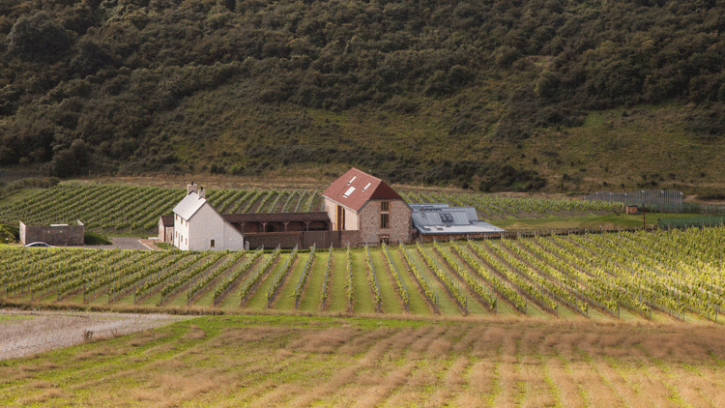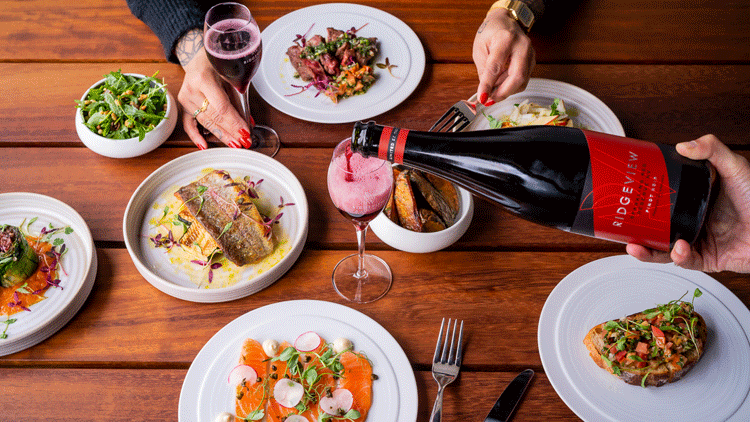Vine dining: the rise of the winery-based restaurant

In 2019 Ridgeview’s Mardi Roberts predicted a major reappraisal of vineyard hospitality in the South of England and beyond in an interview with Restaurant. That piece ended up being spiked due to the pandemic, but a few years on she has been proved right - and then some. UK wineries are now scrambling to introduce - or upgrade existing – facilities to capitalise on the post-Covid boom in domestic and international wine tourism.
Tours, tasting facilities and retail are a given for most wineries that want to throw their doors open to the public, but full-service restaurants are increasingly part of the equation, ranging from high-end tasting menu places to more rustic ventures serving cheese and charcuterie boards (see Pick of the bunch).
Roberts – who is part of the family behind the highly-rated East Sussex winery and oversees its marketing – brings a fresh perspective to the UK wine industry having grown up in Australia, where wine tourism is far more developed.
“Wine tourism in Australia is a multi-billion-dollar industry. For many Australians going to eat and drink in a winery is a standard day out,” she says. “The opportunities for wine tourism in this country are huge, not least because our wineries are far less remote than in some other places. Vineyards in Sussex, for example, are within easy striking distance of London and very close to Gatwick Airport.”
Last year, Ridgeview launched its first permanent restaurant following success with one-off dinners and other food-related events that were often run in partnership with local chefs. Abutting Ridgeview’s Chardonnay plantings, The Rows & Vine is a semi-outdoor venue with heated covered pavilions and an open-air roof terrace with a kitchen and bar underneath.
The small plates menu is affordable with most dishes under £10. “Ridgeview is a high-quality product, but accessibility has always been important for us. We want everyone to be able to come here. There are some exclusive vineyard restaurants in Australia but in general they are affordable and convivial places.”
A growth industry
It is difficult to overstate the success of the UK’s wine industry in recent years. Production is concentrated in Southern England for obvious climatic reasons, but there are also a growing number of vineyards further up the country, in Wales, and even a handful in Scotland.
Plantings have grown 74% over the past five years and more than quadrupled since 2000. WineGB, the trade body for the English and Welsh wine industry, forecasts that plantings could nearly double from 4,000ha to 7,600ha by 2032. “Our mid-range prediction is that we will move from 12.2 million bottles (2022) to 25 to 29 million bottles by 2032. We are on a strong growth trajectory – it is a very exciting time to be in the industry,” says WineGB chair Sam Linter, the former boss of Bolney Wine Estate in West Sussex, which is – it just so happens – in the process of overhauling its hospitality offer.
Current WineGB data shows that wine tourism averages 24% of total revenue for wineries (based on cellar door sales of wine and other goods, hospitality, and other onsite offerings). “Visitor numbers were up last year by 17% on 2021. We estimate that some 273 vineyards are involved in wine tourism in some capacity. We also know from our recent survey of members that more are planning to introduce on-site hospitality in the coming years," Linter adds.
Covering all bases
30 minutes' drive to the east of Ridgeview is Rathfinny, a relative newcomer to the UK wine scene – it released its first commercial bottling in 2018 – but one that is already making waves with both its wines and its multi-faceted hospitality offer.
Located close to the coast near Alfriston, Rathfinny has three (four in summer) separate restaurant offers including its flagship the Tasting Room and the more casual Flint Barns Dining Room which both have spectacular views of the South Downs. Yet hospitality wasn’t initially part of the plan for founders Sarah and Mark Driver.
“It seems strange now but the master plan for the vineyard we put together in 2010 didn’t even mention hospitality. It was all new to us (the pair had previously worked in the city as a solicitor and hedge fund boss respectively) so we focused on the wine. But in the first year of running the business we went to South Africa and released that going to a winery was not just about the wine.”
Sarah wrote a shop and tours into the plans but Rathfinny launched to the public without a restaurant. Soon after, the decision was taken to convert the vineyard’s workers' accommodation (the pair had been told they would never be able to find local people to work on a vineyard, but this proved not to be the case) to The Flint Barns Dining Room. Save for a blip during Covid, the hospitality side of the business has grown steadily since then.
Covid’s silver lining
While the pandemic halted vineyard hospitality just as it was building momentum and put wineries under considerable logistical and financial pressure, the period of enforced closure to the public gave businesses time to plan for - and in some cases even build - new infrastructure for happier times. It also helped that 2020 was one of the best harvests that the UK has ever seen.
Covid also gave the public a newfound appreciation for the outdoors and turned people on to what was on - or at least near - their respective doorsteps. “Vineyards aren’t short of space so were very well-suited to trading in between the lockdowns and immediately after the pandemic. It also made the public hardier. People are much more willing to be outside now,” says Roberts.
Locals have continued to support their wineries, but visitor numbers have now been bolstered by those coming from further afield. "We have always had great local support. But after the pandemic we started to see a younger, hipper crowd coming to us for staycations,” says Sarah. Wineries are surprisingly popular with international tourists too – a recent VisitBritian survey found that 42% of inbound tourists said they would enjoy a visit to a winery.
Wining and dining
Though most vineyard restaurants do offer some wines from further afield, the focus is - quite rightly - on the wines that are produced on site. At Wiston Estate, such wines account for around 80% of sales. As is the case for most English wine producers, the West Sussex winery majors in traditional method sparkling wines but also has a side-line in still wines, including a Pinot Meunier-based rosé, a Pinot Noir-based red and a white made with Chardonnay and Bacchus.
All the wines are high acidity - even with rapidly rising temperatures, the British Isles remains on the fringes of where viticulture is possible - so Chalk executive chef Tom Kemble needs to plan his menus carefully.
"I certainly keep the vineyard's wines in mind when I'm creating dishes. For example, I use a lot of rich buttery sauces such as beurre blanc and hollandaise because they go so well with the sparkling wines we produce. We're lucky here, the quality of the wines is very good. The cuvee range in particular has the power, complexity and richness to stand up to a lot of different foods."
That said, winery-based chefs generally steer clear of dishes that scream for styles of wines that are tricky to produce on these shores, not least big, full-bodied reds. Rathfinny head chef Chris Bailey admits that beef does not feature heavily on his menus but he also believes that English wines are more adaptable than they are sometimes given credit for.
“We have four different sparkling wines and some still wines (sold under the Cradle Valley label) so we have options that will work with a wide variety of flavour profiles. A blanc de noir can be made to work well with red meat, for example, so long as you bear a few things in mind when putting the dish together. It also helps that we do most of our business at lunch when people are often looking for lighter wines anyway.”
Both Kemble and Bailey – who are both good examples of the sort of talent wineries are luring out to the sticks having both attracted Michelin stars at previous postings - make extensive use of their respective vineyard’s wine in their cooking but also wine byproducts including verjus, vinegars and – during the harvest - fresh grapes. They also use waste products from the vineyard and winery, grilling on old vines and broken up barrels and even cook some dishes in vine leaves.
Sustainability is often front of mind at wineries and vineyards. Restaurants are nearly always focused on local ingredients and the winemakers themselves tend to do what they can to have a positive impact on the environment. Strong sustainability credentials are a powerful marketing tool in the wine industry, especially given the growth of ecotourism in recent years. UK wineries to have recently achieved B-Corp status including Rathfinny and Ridgeview.
Challenges and opportunities
Vineyard restaurants have the same headaches as other restaurants, but they do have to contend with some additional ones too. While the UK is more compact and accessible than most wine producing countries, vineyards are often difficult to access by public transport so most guests drive, which can constrain those all-important alcohol sales. Another disadvantage of being out in the countryside is attracting staff.
“You need to have a car to work here really,” says Bailey, who oversees the entirety of Rathfinny’s not insubstantial catering operation. “It can be difficult to recruit, but on the plus side retention is good because it’s a beautiful place to work.”
On top of this, filling tables in the evening can be tricky, with most guests understandably preferring to visit during the day and early evening when they can see the vines. “For this reason it’s particularly difficult to sweat our assets in the colder months. This is why it’s important not to forget the locals, they can form the backbone of your trade in the evening and at quieter times of the year,” says Sarah, who admits that rising costs are making it harder and harder to turn a profit at Rathfinny’s restaurants.
But winery restaurants could almost be considered a loss leader because they drive sales for more profitable endeavours, not least cellar door sales. “Onsite restaurants and other places to eat and drink attract greater footfall and adds to the experience of visiting the vineyard,” says Linter.
Her former business Bolney Wine Estate – which is located to the north of Haywards Heath – will launch a more ambitious restaurant next year after seeing hospitality revenues increase by 91% over the past two years. In common with other larger wineries, the estate is taking a multi-pronged approach. “We want to do something more ambitious here, but we still want to cater for people that want to pop in for a coffee and a glass of wine whenever they like without needing to book,” says general manager James Davis. To this end, Bolney Wine Estate will extend its existing restaurant space to create a 60-cover restaurant on the first floor and a café on the ground floor.
Working together
The winery hospitality space is expanding rapidly, but it seems the general view is that there are enough customers to go around. Vineyards are also seeing the value of working together. “We don't see ourselves as being in head-to-head competition with the places down the road,” says Roberts. “If people come to one vineyard and have a great experience, they may well look to go to another. It also helps that we all do things differently in terms of the wine and the hospitality.”
Vineyards in Sussex – which recently succeeded in a long-running bid to secure PDO status for its sparkling wines – are teaming up to highlight the potential for wine tourism to have a transformational effect on the visitor economy. Launched this month, Sussex Wine Tourism: A Plan For Growth also calls for improved infrastructure to make it easier for people to access vineyards, including better signage and electric vehicles to ferry people around from one site to another.
Roberts and her Sussex-based peers want to take inspiration from the places that have had the biggest success with wine tourism including Australia, South Africa and California and believe that by 2040 Sussex’s expanded wine tourism offer will be a ‘headline act in the region’s visitor story’.
Other counties will likely seek to replicate what Sussex is doing in due course, helping to further strengthen the foundations of what looks likely to become an increasingly prevalent and exciting niche within the restaurant space.
Pick of the bunch: Six vineyard restaurants that are leaning into hospitality
Bolney Wine Estate
Among the UK's first commercial vineyards, Bolney Wine Estate is currently undergoing phase one of an expansion to its hospitality and retail area, which will increase visitor capacity by 120%. Now owned by multinational wine company Freixenet Copestick, the estate remains open to visitors throughout the work, with phase one due to complete in late summer. Phase two will see the West Sussex estate’s café restaurant overhauled to increase capacity and create two distinct dining spaces, a café and a more ambitious restaurant. Bolney Wine Estate says the decision to invest follows a period of substantial growth, with the hospitality side of the business seeing a 91% increase in revenue in the past two years.
Denbies
Just outside Dorking in Surrey, Denbies is one of the UK’s largest single vineyard estates producing around one million bottles a year. It was among the first UK vineyards to see the value in hospitality having launched its first restaurant – The Galley – in 2000. There are now three restaurants on the Surrey Hills-based estate that dovetail with a significant corporate hospitality and weddings business.
Llanerch
Vines were first planted in Llanerch in 1986 but the hospitality side of the estate – which is located near Cardiff – launched in 2011. Difficulty getting people to the site saw owner Ryan Davies launch an onsite boutique hotel just ahead of the pandemic. Not ideal timing, then. But during Covid the team had considerable success with Llanerch Farm Shop, which offered essential items alongside a selection of wine, restaurant-quality meals and luxury goods. During the second Covid lockdown, Davies extended Llanerch’s restaurant space.
Rathfinny
Rathfinny may have only launched in 2010 (it produced its first commercial wine in 2018) but it already has one of the most comprehensive hospitality offerings of any UK vineyard. There's an alfresco wine bar, casual restaurant the Flint Barns Dining Room and the more top-end Tasting Room. It’s possible to stay overnight, and there's also a busy programme of events and special dinners, some of which allow guests to literally eat in the vineyard itself. The whole catering operation is overseen by head chef Chris Bailey, who prior to joining the Alfriston-based business won a Michelin star at Winchester's The Black Rat.
Tillingham
The enfant terrible of the English wine scene creating low-intervention wines that often feature grapes and processes not commonly found on these shores, Tillingham is home not only to vines but also a growing collection of livestock. Its flagship restaurant is headed by former Silo and Aquavit chef Brendan Eades and was recently awarded a Michelin green star for its sustainable modern cooking. There's also the recently renovated Dutch Bar, which offers high quality pizza, and a bar that serves charcuterie and cheese boards.
Wiston Estate
In the West Sussex countryside close to the South Downs, Wiston Estate started producing wine in 2006 and opened an onsite restaurant in 2021 within a renovated 18th century threshing barn. With its high exposed-rafter-supported ceiling, Chalk is an impressive looking space that's now under the auspices of Tom Kemble, who is probably best known for attracting a Michelin star in his early 30s at Mayfair’s Bonhams in 2015. Despite his top end background - his CV prior to leading his own brigade include Fäviken and Hedone - his menu has been carefully designed to accommodate a range of budgets and be deliverable in a kitchen that can do in excess of 100 covers on a busy sunny day. A more ambitious and refined menu that makes even more of the ingredients grown on the 6,000 acre Wiston Estate may be launched further down the line.

























